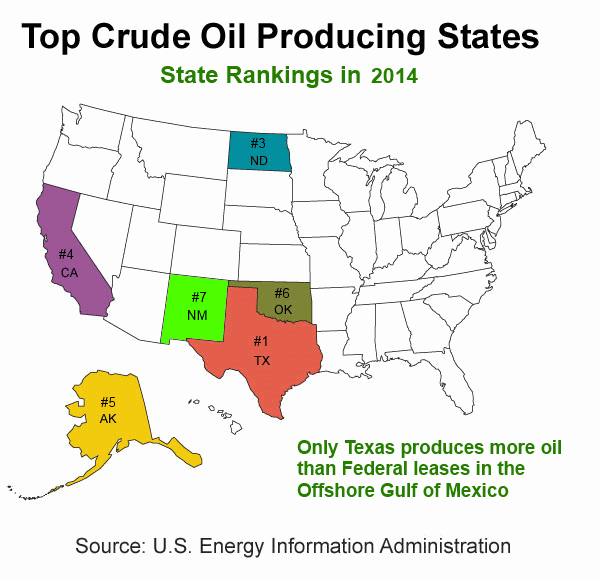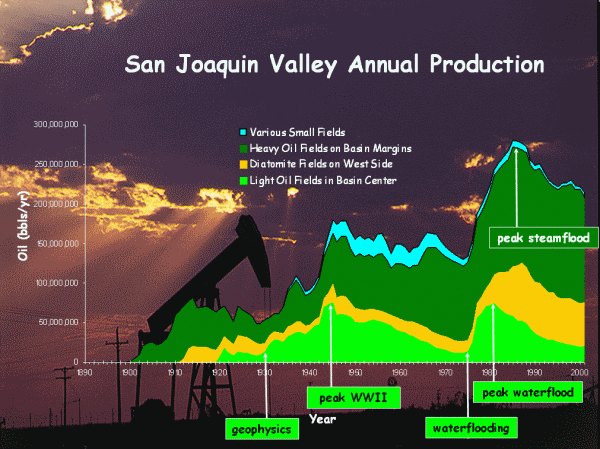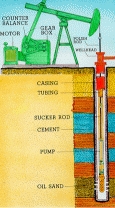|
|
The San Joaquin Valley Oil Industry
 Except for a couple of mediocre wells on the "westside" of the Except for a couple of mediocre wells on the "westside" of the
San Joaquin Valley, and a few tar mining operations, farming was the mainstay of the valley in the late 1800s. However, the 1899 discovery of "black gold" in a shallow hand-dug oil well on the west bank of the Kern River changed all that. The Kern River discovery started an oil boom, and a forest of wooden derricks sprang up overnight on the flood plain just north of Bakersfield, a sleepy farm town known to most as "Bakers Swamp". Soon Kern River production accounted for 7 out of every 10 barrels of oil that came from California, and Kern River field by 1903 had made California the top oil-producing state in the country.
Inspired by the Kern River discovery, "oil prospectors" fanned out across the San Joaquin Valley, and derricks began to pop up everywhere. Many discoveries followed, and a string of spectacular gushers at Coalinga, McKittrick and Midway-Sunset fields kept the valley in the oil news. And of course, there was the Lakeview Gusher . . . the greatest oil well the west, for that matter the country, has ever known.
 Over a century later, the San Joaquin Valley still produces a lot of oil. In fact, the Kern County part of the valley in 2014 had 44,518 producing oil wells, with another 2,098 producing wells in Fresno County. Historically, about 54% of all the oil produced in California has come from the San Joaquin Valley, but The valley for the year 2014 produced about 74% of all the oil produced in the state. Furthermore, oil produced from the San Joaquin Valley in 2014 represents about 4.8% of the entire United States production, and about 0.5% of the total world oil production for the year. The valley ranks behind Texas, the Gulf of Mexico, and North Dakota as the fourth largest oil producing region in the United States. Over a century later, the San Joaquin Valley still produces a lot of oil. In fact, the Kern County part of the valley in 2014 had 44,518 producing oil wells, with another 2,098 producing wells in Fresno County. Historically, about 54% of all the oil produced in California has come from the San Joaquin Valley, but The valley for the year 2014 produced about 74% of all the oil produced in the state. Furthermore, oil produced from the San Joaquin Valley in 2014 represents about 4.8% of the entire United States production, and about 0.5% of the total world oil production for the year. The valley ranks behind Texas, the Gulf of Mexico, and North Dakota as the fourth largest oil producing region in the United States.
The San Joaquin Valley is also home to 22 giant oil fields that have produced over 100 million barrels of oil each, with four "super giants" that have produced over 1 billion barrels of oil. Among these "super gaints" are Midway-Sunset, which is the largest oil field in the lower 49 United States, and Elk Hills, which is the former U.S. Naval Petroleum Reserve. The aforementioned 22 giant fields are responsible for 95% of the cumulative historic production, and they were responsible in 2014 for 96% of the annual production for the entire San Joaquin Valley.

| 2014 |
| Texas |
3,166,000 barrels of oil per day |
| Gulf of Mexico |
1,397,000 barrels of oil per day |
| North Dakota |
1,087,000 barrels of oil per day |
| California |
563,000 barrels of oil per day |
| Alaska |
497,000 barrels of oil per day |
San Joaquin
Valley |
418,000 barrels of oil per day |
| Oklahoma |
343,000 barrels of oil per day |
| New Mexico |
339,000 barrels of oil per day |
U.S. Energy Information Administration (EIA)
Giant Oil Fields of the San Joaquin Valley
| RANK |
FIELD |
DATE |
TOTAL PRODUCTION THROUGH 2014 |
| 1 |
Midway-Sunset |
1894 |
3,131 million barrels of oil |
| 2 |
Kern River |
1899 |
2.195 million barrels of oil |
| 3 |
South Belridge |
1911 |
1,687 million barrels of oil |
| 4 |
Elk Hills |
1911 |
1,397 million barrels of oil |
| |
| 5 |
*Coalinga |
1887 |
958 million barrels of oil |
| 6 |
Buena Vista |
1909 |
675 million barrels of oil |
| 7 |
Cymric |
1909 |
587 million barrels of oil |
| 8 |
*Coalinga East Extension |
1928 |
504 million barrels of oil |
| 9 |
*Kettleman North Dome |
1928 |
459 million barrels of oil |
| 10 |
Lost Hills |
1910 |
458 million barrels of oil |
| 11 |
McKittrick |
1896 |
322 million barrels of oil |
| 12 |
Mount Poso |
1926 |
304 million barrels of oil |
| 13 |
Kern Front |
1912 |
232 million barrels of oil |
| 14 |
North Coles Levee |
1938 |
166 million barrels of oil |
| 15 |
North Belridge |
1912 |
160 million barrels of oil |
| 16 |
Edison |
1928 |
154 million barrels of oil |
| 17 |
Round Mountain |
1927 |
133 million barrels of oil |
| 18 |
Fruitvale |
1928 |
128 million barrels of oil |
| 19 |
Rio Bravo |
1937 |
120 million barrels of oil |
| 20 |
Greeley |
1936 |
117 million barrels of oil |
| 21 |
Yowlumne |
1974 |
113 million barrels of oil |
| 22 |
Poso Creek |
1938 |
105 million barrels of oil |
| |
| 23 |
Mountain View |
1933 |
92 million barrels of oil |
| 24 |
Ten Section |
1936 |
86 million barrels of oil |
| 25 |
Paloma |
1934 |
62 million barrels of oil |
| 26 |
South Coles Levee |
1938 |
60 million barrels of oil |
| *San Joaquin Valley fields located in Fresno County |
| |
San Joaquin Valley
 District 4 (Kern Co.) District 4 (Kern Co.)
 District 5 (Fresno Co.) District 5 (Fresno Co.) |
|
15.2 billion barrels of oil
13.1 billion barrels
2.1 billion barrels |
| |
California |
|
28.3 billion barrels of oil |
DOGGR Production Data Spreadsheet
The graph below shows the cumulative annual oil production from the San Joaquin Valley from 1900 to 2000 - a century of oil! Note how as time has gone by light oil has become less and less important to the San Joaquin Valley oil industry, and heavy oil has become more important. This trend is going to continue into the future.

| Did You Know?
|
 |
 A little known fact is that the southern San Joaquin Valley, and Kern County in particular, produces a tremendous amount of electricity through a process called steam cogeneration. Because about two-thirds of the oil produced in California is "heavy" (in other words, too thick and viscous to flow on its own), steam is pumped into the ground to heat the oil and make it behave more like water and less like molasses. Thus, steam injection makes the oil more mobile and enables it to flow into wells where it can be produced. A little known fact is that the southern San Joaquin Valley, and Kern County in particular, produces a tremendous amount of electricity through a process called steam cogeneration. Because about two-thirds of the oil produced in California is "heavy" (in other words, too thick and viscous to flow on its own), steam is pumped into the ground to heat the oil and make it behave more like water and less like molasses. Thus, steam injection makes the oil more mobile and enables it to flow into wells where it can be produced.
 Cogeneration simply means using steam to first turn turbines and produce electricity before the steam is pumped into the subsurface to heat the heavy oil the sandstone reservoirs. Cogeneration simply means using steam to first turn turbines and produce electricity before the steam is pumped into the subsurface to heat the heavy oil the sandstone reservoirs.
 Enough electricity is produced through cogeneration in the southern San Joaquin Valley to supply the power needs for more than 1.5 million homes. This far exceeds the energy requirements of Kern County, so the excess electricity is sent south over the mountains to power-hungry Los Angeles. Were it not for oil-related cogeneration, the electricity bills of Los Angeles residents would be much higher than they are today. Enough electricity is produced through cogeneration in the southern San Joaquin Valley to supply the power needs for more than 1.5 million homes. This far exceeds the energy requirements of Kern County, so the excess electricity is sent south over the mountains to power-hungry Los Angeles. Were it not for oil-related cogeneration, the electricity bills of Los Angeles residents would be much higher than they are today.
|
Want to learn more about oil and gas?
Then click this link for a list of sites on the subject!
|
|


 Except for a couple of mediocre wells on the "westside" of the
Except for a couple of mediocre wells on the "westside" of the  Over a century later, the San Joaquin Valley still produces a lot of oil. In fact, the Kern County part of the valley in 2014 had 44,518 producing oil wells, with another 2,098 producing wells in Fresno County. Historically, about 54% of all the oil produced in California has come from the San Joaquin Valley, but The valley for the year 2014 produced about 74% of all the oil produced in the state. Furthermore, oil produced from the San Joaquin Valley in 2014 represents about 4.8% of the entire United States production, and about 0.5% of the total world oil production for the year. The valley ranks behind Texas, the Gulf of Mexico, and North Dakota as the fourth largest oil producing region in the United States.
Over a century later, the San Joaquin Valley still produces a lot of oil. In fact, the Kern County part of the valley in 2014 had 44,518 producing oil wells, with another 2,098 producing wells in Fresno County. Historically, about 54% of all the oil produced in California has come from the San Joaquin Valley, but The valley for the year 2014 produced about 74% of all the oil produced in the state. Furthermore, oil produced from the San Joaquin Valley in 2014 represents about 4.8% of the entire United States production, and about 0.5% of the total world oil production for the year. The valley ranks behind Texas, the Gulf of Mexico, and North Dakota as the fourth largest oil producing region in the United States. District 4 (Kern Co.)
District 4 (Kern Co.)


